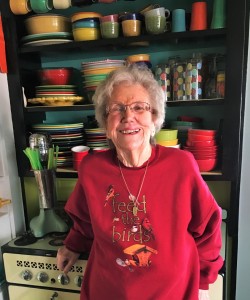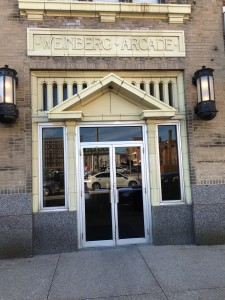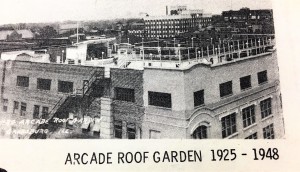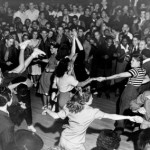“Back then, people were just crazy about dancing. My brother was seven years older than me, and he taught me all the dance moves—especially the jitterbug.”
 These are the words of 88-year-old Ruth (Kemmitt) Pecsi who was kind enough to answer her phone when a perfect stranger called a few weeks ago to ask her about the Roof Garden, a Big Band dance venue on the roof of the Weinberg Arcade in Galesburg, Illinois.
These are the words of 88-year-old Ruth (Kemmitt) Pecsi who was kind enough to answer her phone when a perfect stranger called a few weeks ago to ask her about the Roof Garden, a Big Band dance venue on the roof of the Weinberg Arcade in Galesburg, Illinois.
I needed to get a personal viewpoint of what it was like to go to the Roof Garden back in the late thirties and early forties, because my upcoming novella, The Locket: From the Casebook of TJ Sweeney, will find my detective trying to solve a murder from that period of time. The Roof Garden will be the location where my victim was last seen. As I considered finding sources, it occurred to me that many people who might have talked with me about this era are gone, including my own parents who told me they often went there to dance. But listening to Ruth was much like hearing my parents, since many of them from that “greatest generation” were avid dancers and what you might call “interesting characters.”
The Roof Garden opened officially on July 3, 1929, and closed a couple of years after World War II. But during the 1930’s and 1940’s, it was “the place to be in Galesburg,” especially on Saturday nights.
Ruth Pecsi told me that her family was poor, and she grew up in the Depression. “I worked at a grocery store on South Street from the time I was fourteen, and I saved my money to go to the Roof Garden with my friends on Saturday nights. At our age, my girlfriends and I would dance together because we were too young to dance with men. My parents gave me a strict nine o’clock curfew until I got into high school and then it was midnight—but only on weekends, mind you. We would walk there from home, excited and wondering what band would be there that night. My favorite was Tiny Hill.
“There was a Coffee Corner next to the Illinois Camera Shop on East Main Street. We’d go early and get a hamburger  there. Then we would climb the steps—they were marble. The guys sometimes slid down the railings and there were plenty of those because the dance floor was on the roof, four floors up. We also took the elevator. The Weinberg Arcade had a coffee shop, camera shop, dress shop, and offices, all connected by hallways on each floor.
there. Then we would climb the steps—they were marble. The guys sometimes slid down the railings and there were plenty of those because the dance floor was on the roof, four floors up. We also took the elevator. The Weinberg Arcade had a coffee shop, camera shop, dress shop, and offices, all connected by hallways on each floor.
“In the winter we would go to the Winter Garden on the third floor, and it was inside and more elegant. It had French windows and red drapes, and a glittering ball that hung down from the ceiling and revolved. But you want to know about the Roof Garden…
“On summer nights, it would be crowded with people wanting to dance, and no matter how hot the night, a cool breeze would blow. Lots of people went there just to get cooled off. You could see all of Galesburg from the roof top, and they had put up a railing all around the sides. Davenports and chairs sat around the edge of the dance floor. Twinkling lights were strung around and kind of magical, and the band was in a shell over to one side. A lot of the bands were local, but we also heard Tiny Hill, Lawrence Welk, Tommy Dorsey, and Paul Whiteman.
“On Tuesday nights people went to the dance studio in the building and had ‘instruction’ in all the new dances they were doing in Chicago. Then, on dance nights, especially Saturday nights, you had to buy a ticket to get in, and it cost twenty or twenty-five cents. It was a different time, you know. There was a coat check guy who was black, and an occasional musician  was black, but otherwise the crowd was all white people. You weren’t supposed to bring alcohol, but most of the guys slipped a pint bottle into their coat pockets. We girls could buy Cokes, while the guys often doctored their Cokes with alcohol. Sometimes between sets, the guys went downstairs and across the street to the Oasis bar. Smooching or other displays of affection were frowned upon, and they had security guys there. But never, in all those years, was there a fight or brawl.”
was black, but otherwise the crowd was all white people. You weren’t supposed to bring alcohol, but most of the guys slipped a pint bottle into their coat pockets. We girls could buy Cokes, while the guys often doctored their Cokes with alcohol. Sometimes between sets, the guys went downstairs and across the street to the Oasis bar. Smooching or other displays of affection were frowned upon, and they had security guys there. But never, in all those years, was there a fight or brawl.”
“And soldiers? Were there soldiers?” I asked.
“Oh, yes. You see, the Mayo army hospital was on the north edge of town. [One of sixty-three army hospitals build expressly for casualties of the war, I later learned. It opened in 1943, and because Galesburg was a major railroad town, a special spur was created to offload the wounded. I later worked as a college aide one summer at this hospital in 1967. It had been turned into a mental hospital by then.] So, the patients who were ambulatory could take a bus to the downtown and walk a couple of blocks to the Roof Garden. Then the bus would come back to pick them up. And Knox College had a ROTC program, so many of their air cadets would come to dance during the 1940’s.”
 [Tom Cruise, in “Top Gun,” talked about a particular bar being a “target-rich environment,” for brash fighter pilots, and the Roof Garden would have been such a place too, only for women.]
[Tom Cruise, in “Top Gun,” talked about a particular bar being a “target-rich environment,” for brash fighter pilots, and the Roof Garden would have been such a place too, only for women.]
Ruth continued with, “We danced for hours doing the jitterbug, fox trot, tango, and waltz. Two of my favorite songs were the Five O’Clock Jump and the One O’Clock Jump. And we wore our school clothes: bobby sox, saddle shoes, and pleated skirts. A lot of women met their future husbands there.”
After speaking with Ruth, I thought about two of my favorite images from her memories. First, my imagined picture of the soldiers milling around in their uniforms, many smoking, and waiting for the bus to pick them up to go back to the army hospital. I can imagine that crowd at the corner of Seminary and Main in Galesburg. The second image, which will go into my novella for sure, is her description of the people down on the pavement four floors below, who could clearly hear the band music and were dancing on the sidewalks and in the streets. If you couldn’t afford the price of admission, you still had a little stardust.
Jack Larson, in an opinion piece for the Galesburg Register-Mail, wrote that The Big Band Era lasted from 1935 to 1945. In 1935, “Swing had arrived! The music was to mirror the optimism of a people emerging into a happier economic future after the catastrophic Depression.”
Ruth ended our conversation with the wistful comment that “Eventually the war ended, and everything changed.” [Yes, a decade later, Elvis Presley would show up and my parent’s generation would be appalled. Now I see why.]
The Roof Garden closed down in 1947, the big bands having been appropriated during the war for morale purposes, and some of their members drafted. Television came into vogue and families stayed home to raise their children after the war.
Still, I can’t help but feel that this was a magical oasis in the middle of so much deprivation. And it seems like the perfect place to go back to in my upcoming novella about the small town of Endurance.
Coming in April on Kindle, The Locket: From the Casebook of TJ Sweeney. Coming in another week or so, a second post on the factual information I researched on The Roof Garden.

Hi, Susan! What a wonderful blog post. My mom talked about her dancing days at Louann’s which was reincarnated into a western dance hall when I was young. She loved to dance, but didn’t much as she worked hard at a job and on the farm, saving all her pennies. She would have liked this story. And as I write this, I’m listening to Simply Frank. LOL
Thanks for stopping in, Vicki. That is a common theme from my parent’s generation, that they had to work hard because money was scarce. I think it would have made a night out to dance all the more precious.
This sounds wonderful! I LOVE big band music and got totally into them during the 90s when the music got popular again. My husband and I actually hired a tenor band for our wedding in 1994.
That music had come and gone and come back again. Thanks for the reminder that many people below the age of the greatest generation still enjoys their music!
Great blog piece!
I grew up one street over from Ruth Pecsi when she was raising her family on Lincoln St. As I recall, she was a prize winner in the Carl Sandburg Memoir Contest a few years back, which makes Ruth the perfect resource for recollections of the Roof Garden. (I believe Ruth was also one of the principal drivers in developing the Central Illinois Collegiate Baseball League that sent so many players to the major leagues.}
As for the Roof Garden, I heard all about it as a kid growing up at 952 Arnold St. Of course, it was closed just one year after I was born, but the memories lingered on.
My parents weren’t dancers, but my two aunts–Dad’s younger sisters–had lived with my parents and grandfather all in the same house during WWII. (Kinda of like the family in Woody Allen’s film, “Radio Days”.) Lois and Kate had frequented the Roof Garden every Saturday night during the war, and they were always reminiscing about all the fun they had dancing and flirting with the guys. They ended up marrying brothers; they might have even met them up at the Roof Garden.
My Aunts recalled–just as Ruth does–that many of the bands featured at the Roof Garden were big names back in that day. And, of course, Lawrence Welk continued on to TV, being broadcast in syndication into the 1970’s, so I got a little glimpse of what Lois and Kate had experienced.
My only regret–and it’s a regret about our nation as a whole in those times–is that places such as the Roof Garden were not available to all people, regardless of color or ethnicity. However, i know a little about the brilliant T.J. Sweeney, so I have full confidence that she will bring justice to this old, old, cold case in more ways than one.
Again, Susan: Great blog post based on the reminiscences of a great witness of those times, Ruth Pecsi.
Yes, Jim, she was one of the founders of the baseball league, and she also organized a fishing tournament that began with the bicentennial celebration and lasted another fifteen years under her guidance. She was quite an amazing interview and she is still going strong at age 88.
I also did quite a bit of research at the Galesburg Public Library which has a pretty decent archives about this topic.
And yes, you can trust TJ Sweeney to do whatever needs to be done to right old wrongs. After all, she is usually in cozy mysteries not tragedies.
Susan,
A wonderful blog indeed! Thank you for writing about the Roof Garden and of the wonderful memories. This is very special to me as you see, Ruth Pecsi is my mom. I love listening to all of her memories of her experiences on The Roof Garden. She can still jitter bug to this day!! It is so wonderful to have this in writing as I will add it to my memories of my mom. I remember as a little girl she and my dad would go dancing every Saturday night. Even though the Roof Garden no longer existed, she found other places to express her jitter bug moves. She is an amazing woman. Thank you again for sharing. Yes, she also was a huge part in creating the baseball teams…Central Illinois Collegiate Baseball. She is quite the sports fan as well. Again, Thank you, Patti
Your mother has more energy than I do on most days, and she is twenty years older. I really enjoyed listening to her memories and also her plans. She talks about her children very fondly! She has helped me create an entire chapter (that I just wrote) for my mystery. So I am very grateful. You are lucky that you have her still. My parents also went up to the Roof Garden, but they have been gone since 2007. I should have paid more attention! Thanks for getting back to me!
Susan,
Sometime when I am in Galesburg I would like to meet you. Mom very much enjoyed your visit and company!! She is indeed full of energy. Even with her eye health issues she does not give up. I plan to take a notebook with me from now on to take notes of different memories she shares with me of her past as I know I can’t retain everything she tells me. Good luck with your next book! I plan to read your other mysteries and I look forward to reading the current book you are working on when it is released. Thank you, Patti
Absolutely. Your mom is just amazing. So glad you are planning to get some of her memories down. Thanks for checking out my books, and I’ll contact you.